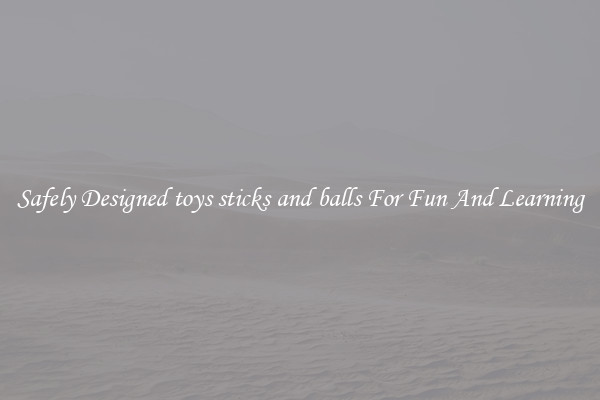Safely Designed toys sticks and balls For Fun And Learning
Safely Designed Toys: Sticks and Balls for Fun and Learning

Toys play a crucial role in a child's development. They not only provide entertainment and playtime but also enhance learning and creativity skills. When it comes to toys, sticks and balls are classic options that have stood the test of time. These simple, yet versatile objects offer endless opportunities for fun, imaginative play, and learning.
Sticks have been used by children for centuries, serving as props for playacting, building tools, and even symbols of power and adventure. They have innate magical qualities that fire up a child's imagination. With a stick in hand, a child can become a knight, an explorer, or a wizard, embarking on exciting journeys in their own world of make-believe. Sticks encourage open-ended play, where there are no limitations or boundaries, allowing children to experience freedom and creativity.
Apart from fostering imaginative play, sticks can also be used for constructive play. Building structures, stacking sticks, or making patterns offer opportunities for problem-solving and critical thinking. Constructing a bridge, building a fort, or creating a sculpture out of sticks requires planning, spatial awareness, and hand-eye coordination. This tactile engagement with sticks enhances a child's fine motor skills and cognitive abilities.
However, it is crucial to ensure that the sticks used for play are safe. Ideally, sticks should be smooth, without sharp edges, splinters, or protruding nails. Parents and caregivers should also supervise play and instruct children on hazards such as poking or hitting others. By setting guidelines and boundaries, sticks can be enjoyed safely while still encouraging creativity and learning.
Similarly, balls are iconic toys that have been loved by children for generations. Whether it's a soccer ball, basketball, or a simple plastic ball, these spherical objects offer endless possibilities for active play and skill development. Ball play helps children improve coordination, balance, and spatial awareness. Kicking, throwing, catching, and bouncing a ball enhances gross motor skills, hand-eye coordination, and muscle strength.
Balls also encourage social interaction and teamwork. Playing ball games with friends or siblings promotes cooperation, communication, and sportsmanship. It teaches children to take turns, share, and work in a team setting. These interpersonal skills are crucial for a child's emotional development and social integration.
When selecting balls for play, it is essential to consider their size and material. Balls should be age-appropriate and suitable for the child's developmental stage. Ensure that the material used is safe and free from harmful chemicals. Soft, lightweight balls are a great option for younger children to prevent accidents or injuries.
In conclusion, the timeless appeal of sticks and balls as toys lies in their simplicity and versatility. They foster imaginative play, encourage creativity, and promote physical and cognitive development. However, safety should always be a priority. By selecting safe sticks and balls and supervising play, parents and caregivers can provide a conducive environment for children to have fun, learn, and grow.

View details

View details

View details

View details








